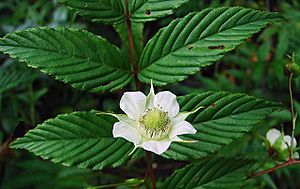Mountain raspberry facts for kids
Quick facts for kids Mountain raspberry |
|
|---|---|
 |
|
| Flower and leaves | |
| Scientific classification | |
| Genus: |
Rubus
|
| Species: |
fraxinifolius
|
| Synonyms | |
|
|
Rubus fraxinifolius, often called the mountain raspberry, is a cool plant from the Asian continent. It's a type of flowering plant that grows as a shrub. This plant is part of the raspberry family, which means it's related to other yummy berries you might know! It also has another name, ragimot.
Contents
What Does the Mountain Raspberry Look Like?
The mountain raspberry grows as a straight-up shrub. It can reach a height of about 2 to 3 meters, which is like two or three tall adults standing on top of each other! Its stems have thorns, so be careful if you ever see one.
Leaves and Flowers
The leaves of this plant are oval-shaped. They are also pinnate, which means they have smaller leaflets arranged along a central stem, like a feather. Each leaf can be 2 to 9 centimeters long and about 1.4 centimeters wide. The edges of the leaves are serrated, meaning they look like the teeth of a saw.
The mountain raspberry produces beautiful white flowers. These flowers grow in clusters called inflorescences. Specifically, they form panicles, which are branched clusters of flowers.
Fruits
After the flowers bloom, the plant grows yummy fruits. These fruits are orange to red in color and have an oval shape. They can be up to 2.5 centimeters long and 1.5 centimeters wide. The fruits are aggregate fruits, which means they are made up of many tiny little parts called drupelets. Each drupelet is like a tiny berry with a small seed inside.
Where Does the Mountain Raspberry Grow?
The mountain raspberry is found in many parts of Southeast Asia and Melanesia. You can find it in places like Taiwan, the Philippines, Borneo, Java, Sulawesi, New Guinea, and the Solomon Islands.
Habitat
This plant loves to grow in open areas. It also likes places where the ground has been disturbed. For example, you might see it on landslides, along riverbanks, or next to roads. It can grow from lowlands all the way up to high elevations. You can find it up to 3,000 meters high in montane forests, which are forests that grow on mountains.

